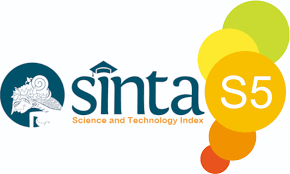PEMETAAN KAWASAN RAWAN BANJIR KABUPATEN LANDAK
DOI:
https://doi.org/10.33541/cen.v5i1.5632Keywords:
Flooding, Landak Regency, Flood-prone Areas, Geographic Information SystemAbstract
Flooding is a global natural disaster that occurs frequently, including in the Landak Regency. From several studies that have been conducted in the Landak Regency area, it is known that there has been an increase in the frequency of flooding in the period 1998-2021, and flooding that occurs not only in urban areas but also in rural areas which are upstream of the Landak Sub-watershed. For this reason, information on flood-prone areas in Landak Regency is needed through geospatial maps to minimize flooding in the area. This research aims to map flood-prone areas and determine the classification of flood-prone levels in the Landak Regency.
In this research, the data used are (a) data from observation and documentation in the field during floods, (b) data from Focus Group Discussion (FGD) conducted at the hall of the Landak Regency Public Works Office, which discussed flood control strategies in the Landak Subwatershed, (c) data on land slope, land elevation, soil type, land cover, rainfall, river buffer, inundation duration, and inundation height. Then, an overlay of the eight parameters was done, a zoning map of flood-prone areas was made, and the level of the flood-prone regions in Landak Regency was determined.
Based on the analysis, the Landak Regency's areas of shallow, low, and moderate vulnerability to flooding are, respectively, 62,819.28 ha (7.58%), 184,504.24 ha (22.28%), 187,524.53 ha (22.64%), high, and very high (19.98%) levels of vulnerability to flooding. Landak Regency's Ngabang Sub-district (53,787.37 ha), Sebangki Sub-district (50,405.59 ha), and Mandor Sub-district (33,800.63 ha), which comprise Sebangki Village, Sungai Segah, Rantau Panjang, Kumpang Tengah, Sumsum, Sekilap, Keramas, Manggang, Amboyo Selatan, and Temiang Sawi, are among the areas with extremely high flood vulnerability.
References
Akafi, M. M., Soeryamassoeka, S., Gunarto, D., Nirmala, A., & Danial, M. M. (2023). Determination of the Priority Scale of Flood Management in the Landak Sub-Watershed. Jurnal Teknik Sipil, 23(2), 211. https://doi.org/10.26418/jtst.v23i2.64168
Alfaro, A., Soeryamassoeka, S., Gunarto, D., Umar, U., & Yulianto, E. (2023). Flood Management Strategy in the Landak Sub-River Basin Using Swot Analysis. Jurnal Teknik Sipil, 23(1), 93. https://doi.org/10.26418/jtst.v23i1.61790
Ardiansyah, M., Ngudiantoro, N., & Siswanto, A. (2023). Mapping of Flood-Prone Areas as a Flood Disaster Mitigation Effort in the Lambidaro Sub-Watershed, Palembang City. Sriwijaya Journal of Environment, 8(2), 82–91.
BNPB. (2022). Pra-Rakornas PB, Deputi Bidang Pencegahan BNPB: Penguatan Pengurangan Risiko dalam Penanggulangan Bencana. Bnpb.Go.Id. https://bnpb.go.id/berita/prarakornas-pb-deputi-bidang-pencegahan-bnpb-penguatan-pengurangan-risiko-dalam-penanggulangan-bencana
Fiantis, D. (2015). Morfologi dan Klasifikasi Tanah. Lembaga Pengembangan Teknologi Informasi dan Komunikasi.
Fiati, R., & Latubessy, A. (2016). Mapping of flooded areas in the Kudus District. Indonesian Journal of Electrical Engineering and Computer Science, 4(3), 670–677. https://doi.org/10.11591/ijeecs.v4.i3.pp670-677
Jha, A. K., Bloch, R., & Lamond, J. (2012). Cities and flooding: a guide to integrated urban flood risk management for the 21st century. World Bank Publications.
M Amen, A. R., Mustafa, A., Kareem, D. A., Hameed, H. M., Mirza, A. A., Szydłowski, M., & Bala, B. K. (2023). Mapping of Flood-Prone Areas Utilizing GIS Techniques and Remote Sensing: A Case Study of Duhok, Kurdistan Region of Iraq. Remote Sensing, 15(4). https://doi.org/10.3390/rs15041102
Purwanto, A., Rustam, Eviliyanto, & Andrasmoro, D. (2022). Flood Risk Mapping Using GIS and Multi-Criteria Analysis at Nanga Pinoh West Kalimantan Area. Indonesian Journal of Geography, 54(3), 463–470. https://doi.org/10.22146/IJG.69879
Putri, S. B., Meirany, J., Pratiwi, N. N., Lestari, A. D., & Danial, M. M. (2023). Pemetaan Daerah Rawan Bencana Dalam Upaya Mitigasi Bencana Berbasis GIS Di Kecamatan Sungai Raya Kepulauan Kabupaten Bengkayang Provinsi Kalimantan Barat. Jurnal Inovasi Sains Dan Teknologi Kelauta, 4(3), 23–29.
Soeryamassoeka, S. B., Kartini, Herawati, H., & Irwansyah, M. A. (2022). Pengelolaan Banjir Terpadu di Kalimantan Barat (Studi Kasus: DAS Landak).
Soeryamassoeka, S. B., & Wuysang, J. E. (2014). Kajian Banjir di Kecamatan Jelimpo, Kabupaten Landak.
Xie, Y., Wang, J., & Yao, L. (2017). Economic Losses Caused by Flood Disasters in China from 2005 to 2017. Natural Hazards, 102(3), 2253–2265.
Downloads
Published
How to Cite
Issue
Section
License
Hak Cipta atas Tulisan Karya Ilmiah
Bersama dengan ini saya sebagai penulis utama menyatakan bahwa paper yang saya kirimkan untuk dipublikasikan melalu Jurnal Rekayasa Teknik Sipil dan Lingkungan adalah benar merupakan hasil orisinil Tulisan Karya Ilmiah yang merupakan hasil penelitian/kajian yang saya lakukan dan belum pernah dipublikasikan pada penerbit Jurnal ilmiah lain di Indonesia.
Jika di kemudian hari ternyata ditemukan bukti adanya hal-hal yang tidak sesuai dari pernyataan diatas maka saya bersedia menerima konsekuensi yang diberikan oleh Dewan Redaksi Jurnal Rekayasa Teknik Sipil dan Lingkungan serta paper yang telah diterbitkan akan DIBATALKAN dan dinyatakan sebagai hasil karya PLAGIASI.









